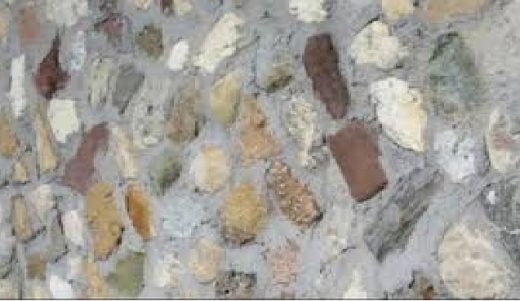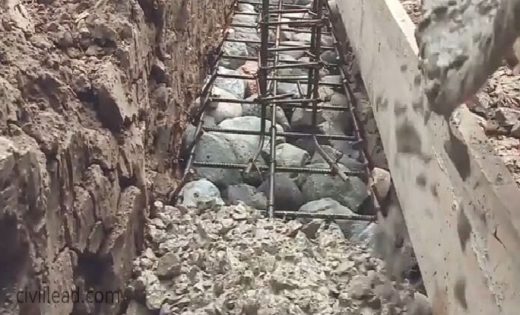What is Plum Concrete?
Plum concrete, also known as cyclopean concrete and rubble concrete, combines wet concrete and a plum (large size, strong, clean natural coarse aggregate or boulders of roughly 300 mm or larger). Plum makes up about 30–40% of the overall weight of the poured-in-place material.
U.S. technical specifications recommend a ratio of 60 percent plain concrete to 40 percent big stones when building with Cyclopean concrete. On day 28, the plain concrete used in this project must have a minimum resistance of 180 kg/cm2, and its ingredients must be thoroughly saturated before being mixed. The stone used must be in line with ASTM standards, and the blueprints will determine the exact dimensions for the foundation.
Plum’s presence in concrete lowers the required hydration heat since it eliminates the need for an excessive amount of cement while maintaining the material’s strength. Constructions of gravity dams, embankments, filling of deep or uneven terrain, foundations, etc., are all common applications for plum concrete. It’s a cheap replacement for regular cement.

Fig 1: Plum Concrete
Courtesy: engineersforum.com.ng
Properties of Plum Concrete:
- Natural stone or boulders, i.e., plum, often range in diameter from about 150 mm to 300 mm. The size is settled upon after careful consideration of the undertaking, the accessibility of relevant resources, and the outcomes of relevant engineering judgments.
- Sharp-edged stones work well for making plum concrete.
- The plum must be clear of grease, grime, and anything else that could prevent it from adhering or bonding to the concrete.
- In addition to being high-quality and long-lasting, it should also be free of segregation, seams, cracks, and any other structural flaws or blemishes.
- Surfaces on plums shouldn’t be rounded off from wear and weathering.
How to Prepare Plum Concrete?

Fig 2: Preparation of Plum Concrete
Courtesy: civillead.com
Plum concrete can either be created by adding the plum to the concrete mix during the mixing of concrete or by distributing the plums over the layer of standard concrete and then spreading another layer of concrete. Special attention must be made while inserting the plums into the concrete to prevent air traps. The basic steps of making plum concrete are as follows:
- Stones used in plum material should be durable, long-lasting, and of the same rock type used to make aggregates.
- None of the dirt or clay should be flaking or visible.
- Dust on the plum material needs cleaning before it can be used.
- First, the stones necessary for manufacturing plum concrete are meticulously hand-picked. As a result, the plum material has been batched. The size of the plum substance should be up to roughly 300mm.
- The size of the plum material should be limited to roughly 1/3rd of the overall volume of concrete. Workers may choose to hand-pick the plum material or may choose at random and bring it to the site.
- When the material is compacted tightly, the required concrete can be reduced by up to fifty percent.
- After the plum material has been distributed, a layer of concrete is put on top. When the concrete has had time to harden and fill in the spaces between the plum materials, a new layer of plum materials is applied on top. It is done over and over again until the desired effect is achieved. Pay close attention when pouring plum concrete to prevent air pockets from forming, as they can weaken the finished product.
- After the plum concrete has been properly layered, it is neatly finished and allowed to cure for at least 14 days. Numerous approaches can be used to effect a cure. The plum concrete can be sprayed with water at regular intervals, or wet jute bags can be placed on top of the concrete.
Difference between Plain Concrete and Plum Concrete:
The simplest sort of concrete is plain cement concrete. It is created by mixing basic building materials like cement, fine aggregates, and coarse aggregates. In contrast, plum concrete is a type in which large to very large stones are used as filler material rather than aggregates.
The expansion of the large stones in the concrete mixture thus serves as the primary distinction between plum concrete and plain cement concrete. It functions as a filler by reducing the need for small aggregates, which are frequently expensive. It contributes to reducing the cost of concrete in this way.
Specifications Of Plum Concrete:
- Each layer plum concert maximum height of 900mm did not surpass more height in one layer
- Maximum apertures in one layer 150 mm only
- Plum concrete uses maximum M10 Grade concrete in this concrete aggregate of a maximum size of 25mm.
- The concrete’s plum volume will not exceed 40% (percent) of the overall volume.
- Plum shall include black trap basalt of crushing strength of a minimum of 100 Kg /Sq.cm.
- Plum concrete density 1650 kg/Cubic. meter
Applications of Plum Concrete:
- When the earth is uneven beneath the foundation, this concrete is utilized to smooth it out. As a bonus, it can flatten uneven surfaces in hilly or sloping areas.
- When adding weight to a foundation is the only reason to use mass concreting, as is the case with a machine foundation, this technique is put to use.
- Plum concrete allows for cost reduction in the basis. Plum concrete is used when the foundation is on sloping ground to ensure the building doesn’t sink.
- Plump concrete is in high demand in building enormous buildings like dams and bridges that rely on gravity for their support. Nonetheless, the maximum allowable thickness for plum material used in building bridges and dams is just 150 millimeters.
- In the building of road barriers, plum concrete is frequently used. It is built into the dam’s side slopes to add a layer of protection to a soil-based base.
- The water channels’ bed surfaces are leveled with plum concrete. Because of their typically subterranean location, water distribution networks demand robust construction. Therefore, such buildings benefit most from plum concrete.
- It is frequently used in situations where the stability of the foundation and the machine is dependent on a large mass.
Advantages of Plum Concrete:
- Reduces the cost of concrete work when mass concrete work and big amounts of concrete are required.
- The plums utilized are robust and contribute to the strength of the concrete.
- It is extremely resistant to wear and tear. It is also a fire-resistant and water-resistant substance.
Disadvantages of Plum Concrete:
- Since the tensile area of Plum Concrete is so weak, it requires reinforcement steel.
- Inexpensive formwork is required for casting, molding, and holding the plum concrete until it cures sufficiently.
- Consequences of using concrete include large buildings and long-span constructions needing stronger materials to support their weight, and concrete’s poor strength per unit weight results in heavier members.
- Unlike the production of materials like laminated wood and structural steel, there are fewer regulations governing the installation and curing of plum concrete.
- Since concrete might take up to 28 days to fully cure before it can be used for building, this is a disadvantage because it means more work and water.
- Concrete production harms the environment since it requires more resources and generates more carbon dioxide than alternatives like steel and glass.
Conclusion:
When a substantial amount of concrete is required below a structure’s foundation or footing to create a level surface for the equally distributed application of load, plum concrete is employed. Plum concrete has proven to be a cost-effective option for large-scale construction where mass concreting is required.
A filler material made of medium to large stones is used in plum concrete, a form of concrete. The cost of concrete can be decreased by adding large-sized filler stones without compromising the strength or functionality of the structure.
References:
1. “Plum Concrete.” Plum Concrete – Designing Buildings, www.designingbuildings.co.uk, and https://www.designingbuildings.co.uk/wiki/Plum_concrete. Accessed 14 Aug. 2022.
2. “What Is the Difference between Plum Concrete and Plain Concrete.Docx?” Scribd, www.scribd.com,https://www.scribd.com/document/407444793/What-is-the-difference-between-plum-concrete-and-plain-concrete-docx. Accessed 14 Aug. 2022.
3. “What Is Plum Concrete?/ All about Plum Concrete.” What Is Plum Concrete?/ All about Plum Concrete. ~ PARAM VISIONS, www.paramvisions.com, 22 July 2022, https://www.paramvisions.com/2022/07/what-is-plum-concrete-all-about-plum.html.
4. “Plum Concrete Methodology | Plum Cement Concrete.” Plum Concrete Methodology | Plum Cement Concrete, www.constructioncost.co, https://www.constructioncost.co/plum-concrete.html. Accessed 14 Aug. 2022.
5. “IMPORTANT POINTS TO REMEMBER FOR ‘PLUM CONCRETE’ WORK.” IMPORTANT POINTS TO REMEMBER FOR ‘PLUM CONCRETE’ WORK, www.blogforcivilengineers.com,https://www.blogforcivilengineers.com/2020/11/important-points-to-remember-for-plum.html. Accessed 20 Aug. 2022.
If you have a query, you can ask a question here.



Can you please share link for the referred US technical specifications